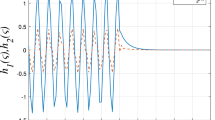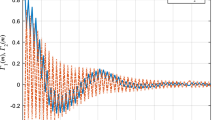Abstract
This study considers the stability and passivity analysis of discrete-time systems with variable time-lags, saturation overflow nonlinear effects and external disturbances. Summation inequality based on free-weighting matrices is employed to develop an enhanced stability criterion that is in the form of linear matrix inequalities. A sufficient passivity condition for discrete-delayed systems involving overflow nonlinearities and subjected to external interferences is also proposed. Illustrative examples are presented to demonstrate the effectiveness of the obtained results.




Similar content being viewed by others
References
C.K. Ahn, Strictly passive suppression of limit cycles in direct form digital filters with saturation nonlinearity: linear matrix inequality approach. Math. Methods in the Appl. Sci. 36(18), 2449–2455 (2013)
C.K. Ahn, P. Shi, Generalized dissipativity analysis of digital filters with finite-wordlength arithmetic. IEEE Trans. Circuits Syst. II Express Briefs 63(4), 386–390 (2015)
C.K. Ahn, P. Shi, Strict dissipativity and asymptotic stability of digital filters in direct form with saturation nonlinearity. Nonlinear Dyn. 85(1), 453–461 (2016)
S.X. Arockiaraj, P. Kokil, H. Kar, Passivity based stability condition for interefered digital filters, Indonesian Journal of Electrical Engineering and Computer. Science 6(2), 431–437 (2017)
K. Chakrabarty, S.S. Iyengar, H. Qi, E. Cho, Grid coverage for surveillance and target location in distributed sensor networks. IEEE Trans. Comput. 51(12), 1448–1453 (2002)
J. Chen, L. Junwei, X. Shengyuan, Summation inequality and its application to stability analysis for time-delay systems. IET Control Theory & Appl. 10(4), 391–395 (2016)
A. Duminda, Dewasurendra, P.H. Bauer, A novel approach to grid sensor networks, Proceedings of 15th IEEE International Conference of Electronics, Circuits and Systems, IEEE, pp. 1191–1194 (2008)
A.A. Abd-El-Latif, B. Abd-El-Atty, M. Amin, A.M. Iliyasu, Quantum-inspired cascaded discrete-time quantum walks with induced chaotic dynamics and cryptographic applications. Sci. Rep. 10(1), 1–16 (2020)
Z. Feng, J. Lam, G.H. Yang, Optimal partitioning method for stability analysis of continuous/discrete delay systems. Int. J. Robust Nonlinear Control 25(4), 559–574 (2015)
J. Fredes, J. Novoa, S. King, R.M. Stern, N.B. Yoma, Locally normalized filter banks applied to deep neural-network-based robust speech recognition. IEEE Signal Process. Lett. 24(4), 377–381 (2017)
H. Gao, T. Chen, New results on stability of discrete-time systems with time-varying state delay. IEEE Trans. Autom. Control 52(2), 328–334 (2007)
Y. He, W. Min, G.P. Liu, J.H. She, Output feedback stabilization for a discrete-time system with a time-varying delay. IEEE Trans. Autom. Control 53(10), 2372–2377 (2008)
Y. Hong, Y. Lian, A memristor-based continuous-time digital FIR filter for biomedical signal processing. IEEE Trans. Circuits Syst. I Regul. Pap. 62(5), 1392–1401 (2015)
V.K.R. Kandanvli, H. Kar, Robust stability of discrete-time state-delayed systems with saturation nonlinearities: Linear Matrix Inequality approach. Signal Process. 89(2), 161–173 (2009)
V.K.R. Kandanvli, H. Kar, Delay-dependent stability criterion for discrete-time uncertain state-delayed systems employing saturation nonlinearities. Arab. J. Sci. Eng. 38(10), 2911–2920 (2013)
P. Kokil, C.G. Parthipan, Stability of digital filters subject to external interference and state-delay. Trans. Inst. Meas. Control. 42(13), 2559–2568 (2020)
P. Kokil, C.G. Parthipan, S. Jogi, H. Kar, Criterion for realizing state-delayed digital filters subjected to external interference employing saturation arithmetic. Clust. Comput. 22(6), 15187–15194 (2019)
M.K. Kumar, P. Kokil, H. Kar, Novel ISS criteria for digital filters using generalized overflow non-linearities and external interference. Trans. Inst. Meas. Control. 41(1), 156–164 (2019)
O.M. Kwon, M.J. Park, J.H. Park, S.M. Lee, E.J. Cha, Improved robust stability criteria for uncertain discrete-time systems with interval time-varying delays via new zero equalities, IET Control Theory & Applications 6(16), 2567–2575 (2012)
O.M. Kwon, M.J. Park, J.H. Park, S.M. Lee, E.J. Cha, Stability and stabilization for discrete-time systems with time-varying delays via augmented Lyapunov-Krasovskii functional, J. Franklin Institute 350(3), 521–540 (2013)
J. Liu, J. Zhang, Note on stability of discrete-time time-varying delay systems. IET Control Theory & Appl. 6(2), 335–339 (2012)
R. Liu, X. Hongxiang, E. Zheng, Y. Jiang, Adaptive filtering for intelligent sensing speech based on multi-rate LMS algorithm. Clust. Comput. 20, 1493–1503 (2017)
X.G. Liu, F.X. Wang, M.L. Tang, Auxiliary function-based summation inequalities and their applications to discrete-time systems. Automatica 78, 211–215 (2017)
J. Lofberg, YALMIP: A toolbox for modeling and optimization in MATLAB, Proceedings of Computer Aided Control Systems Design Conference, Taipei, Taiwan, pp. 284–289 (2004)
M.S. Mahmoud, Stabilization of interconnected discrete systems with quantization and overflow nonlinearities. Circuits Syst. Signal Process. 32, 905–917 (2013)
T.J. Mary, R. Parthasarathy, Delay-dependent stability analysis of microgrid with constant and time-varying communication delays. Electric. Power Componen. Syst. 44(13), 1441–1452 (2016)
X. Meng, J. Lam, D. Baozhu, H. Gao, A delay-partitioning approach to the stability analysis of discrete-time systems. Automatica 46(3), 610–614 (2010)
P. Naghshtabrizi, J.P. Hespanha, A.R. Teel, Stability of delay impulsive systems with application to networked control systems. Trans. Inst. Meas. Control. 32(5), 511–528 (2010)
P.T. Nam, P.N. Pathirana, H. Trinh, Discrete Wirtinger-based inequality and its application, Journal of the Franklin Institute 352, 1893–1905 (2015)
P.T. Nam, H. Trinh, P.N. Pathirana, Discrete inequalities based on multiple auxiliary functions and their applications to stability analysis of time-delay systems. J. Franklin Inst. 352(12), 5810–5831 (2015)
R. Nigam, S.K. Tadepalli, Criterion to determine the stability of systems with finite wordlength and delays using Bessel-Legendre inequalities, Robotics, Control and Computer Vision. Lecture Notes in Electrical Engineering (Singapore), Springer Nature Singapore, pp. 271–281 (2023)
V. Chandra Pal, R. Negi, Q. Zhu, Stabilization of discrete-time delayed systems in presence of actuator saturation based on Wirtinger inequality, Math. Problem. Eng. 2019 (2019)
S. Pandey, B. Das, S.K. Tadepalli, Comments on “New finite-sum inequalities with applications to stability of discrete time-delay systems’’. Automatica 91, 320–321 (2018)
S. Pandey, S.K. Tadepalli, V.K.R. Kandanvli, H. Kar, Improved criterion for stability analysis of discrete-time systems subject to saturation nonlinearities and variable time-lags, Proceedings of 2019 IEEE 1st International Conference on Energy, Systems and Information Processing (ICESIP), IEEE, pp. 1–5 (2019)
P. Park, J.W. Ko, C. Jeong, Reciprocally convex approach to stability of systems with time-varying delays. Automatica 47(1), 235–238 (2011)
C.G. Parthipan, X.S. Arockiaraj, P. Kokil, New passivity results for the realization of interfered digital filters utilizing saturation overflow nonlinearities. Trans. Inst. Meas. Control. 40(15), 4246–4252 (2018)
C.G. Parthipan, P. Kokil, Stability of digital filters with state-delay and external interference. Circuits Syst. Signal Process. 40(8), 3866–3883 (2021)
C.G. Parthipan, P. Kokil, Delay-dependent stability analysis of interfered digital filters with time-varying delay and saturation nonlinearities. Circuits Syst. Signal Process. 41(10), 5765–5784 (2022)
C. Peng, Y.C. Tian, D. Yue, Output feedback control of discrete-time systems in networked environments. IEEE Transactions on Systems, Man, and Cybernetics-Part A: Systems and Humans 41(1), 185–190 (2010)
S.B. Qiu, X.G. Liu, F.X. Wang, Q. Chen, Stability and passivity analysis of discrete-time linear systems with time-varying delay. Syst. Control Lett. 134, 104543 (2019)
A. Seuret, F. Gouaisbaut, E. Fridman, Stability of discrete-time systems with time-varying delays via a novel summation inequality. IEEE Trans. Autom. Control 60(10), 2740–2745 (2015)
T. Shen, Z. Yuan, X. Wang, Stability analysis for digital filters with multiple saturation nonlinearities. Automatica 48(10), 2717–2720 (2012)
K. Singh, P.K. Gupta, D. Chaurasia, V.K.R. Kandanvli, Stability of discrete-time delayed systems subject to external interference and generalized overflow nonlinearities, IEEE Transactions on Industry Applications 58(4), 5353–5364 (2022)
K. Singh, V.K.R. Kandanvli, H. Kar, Limit cycle-free realization of discrete-time delayed systems with external interference and finite wordlength nonlinearities. Circuits Syst. Signal Process. 41(8), 4438–4454 (2022)
J.F. Sturm, Using SeDuMi 1.02, a MATLAB toolbox for optimization over symmetric cones. Optimiz. Methods and Softw. 11(1–4), 625–653 (1999)
Z.T. Njitacke, J. Kengne, H.B. Fotsin, Coexistence of multiple stable states and bursting oscillations in a 4D Hopfield neural network. Circuits Syst. Signal Process. 39, 3424–3444 (2020)
S.K. Tadepalli, V.K.R. Kandanvli, H. Kar, Stability criteria for uncertain discrete-time systems under the influence of saturation nonlinearities and time-varying delay, ISRN Applied Mathematics 2014 (2014)
S.K. Tadepalli, V.K.R. Kandanvli, Improved stability results for uncertain discrete-time state-delayed systems in the presence of nonlinearities. Trans. Inst. Meas. Control. 38(1), 33–43 (2016)
S.K. Tadepalli, V.K.R. Kandanvli, A. Vishwakarma, Criteria for stability of uncertain discrete-time systems with time-varying delays and finite wordlength nonlinearities. Trans. Inst. Meas. Control. 40(9), 2868–2880 (2018)
S.K. Tadepalli, V.K.R. Kandanvli, Delay-dependent stability of discrete-time systems with multiple delays and nonlinearities. Int. J. Innov. Comput. Inf. Control 13(3), 891–904 (2017)
F.X. Wang, X.G. Liu, M.L. Tang, Y.J. Shu, Stability analysis of discrete-time systems with variable delays via some new summation inequalities. Adv. Difference Equ. 2016(1), 1–20 (2016)
S. Wen, L. Xing, H. Xiaoqing, H. Zhang, Measurement-converted Kalman filter tracking with Gaussian intensity attenuation signal in wireless sensor networks. Int. J. Distrib. Sens. Netw. 13(4), 1550147717700896 (2017)
Y. Xiao, Y.Y. Cao, Z. Lin, Robust filtering for discrete-time systems with saturation and its application to transmultiplexers. IEEE Trans. Signal Process. 52(5), 1266–1277 (2004)
Y. Junyan, Z. Deng, Y. Mei, Y. Gao, Design of multiple controllers for networked control systems with delays and packet losses. Trans. Inst. Meas. Control. 35(6), 720–729 (2013)
C.K. Zhang, Y. He, L. Jiang, M. Wu, An improved summation inequality to discrete-time systems with time-varying delay, Automatica 74, 10–15 (2016)
D. Zhang, Y. Li, Passivity analysis for discrete-time switched neural networks with various activation functions and mixed time delays. Nonlinear Dyn. 67(1), 403–411 (2012)
Acknowledgements
The authors wish to thank the anonymous reviewers and the Associate Editor for their constructive comments and suggestions for improving the quality of the manuscript.
Funding
The author(s) received no financial support for the research, authorship, and/or publication of this article from any funding agency in the public, commercial, or not-for-profit sectors.
Author information
Authors and Affiliations
Corresponding author
Ethics declarations
Conflict of interest
The author(s) declared no potential conflicts of interest with respect to the research, authorship, and/or publication of this article.
Additional information
Publisher's Note
Springer Nature remains neutral with regard to jurisdictional claims in published maps and institutional affiliations.
Appendix. Proof of Theorem 1
Appendix. Proof of Theorem 1
Proof
Let us consider the LKF [6, 41, 55] as
where
Next, on calculating the finite difference of the above LKF along the trajectories of system (1) we have
Now, by employing Lemma 1 the summation terms in (A.4) can be expressed as
and
On the same lines as above, the second and third sum terms of (A.5) can be estimated by making use of the last inequality in Remark 3 of [40] as follows:
and
Employing (A.2) to (A.10), we obtain the following inequality
where
In view of (4), the quantity ‘\(\delta \)’ given by (A.12) is non-negative [42]. Because of the non-negativeness of ‘\(\delta \)’, one can conclude from (A.11) that \(\Delta V(\varvec{\chi }(\vartheta )) < {\varvec{0}}\) if \((\varvec{\Omega _1} + \varvec{\Omega _2} + \varvec{\Omega _3})< {\varvec{0}}\). By Schur’s complement, \((\varvec{\Omega _1} + \varvec{\Omega _2} + \varvec{\Omega _3}) < {\varvec{0}}\) if and only if the inequalities (8) and (9) hold. Therefore, the conditions (8), (9) and (10) are the asymptotical stability conditions for the system characterised by (1)–(2). Hence, we reach the end of an improved stability condition with the above proof. \(\square \)
Rights and permissions
Springer Nature or its licensor (e.g. a society or other partner) holds exclusive rights to this article under a publishing agreement with the author(s) or other rightsholder(s); author self-archiving of the accepted manuscript version of this article is solely governed by the terms of such publishing agreement and applicable law.
About this article
Cite this article
Pandey, S., Tadepalli, S.K., Bhusnur, S. et al. Improved Stability and Passivity Results for Discrete Time-Delayed Systems with Saturation Nonlinearities and External Disturbances. Circuits Syst Signal Process 43, 103–123 (2024). https://doi.org/10.1007/s00034-023-02465-5
Received:
Revised:
Accepted:
Published:
Issue Date:
DOI: https://doi.org/10.1007/s00034-023-02465-5




